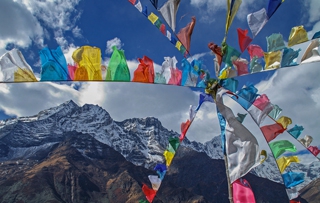The Meaning of Prayer Flags
If you go on an Everest Base Camp trek, you’ll come across numerous prayer flags along the way: bright rectangles of cloth strung along mountain ridges and peaks or tied to sacred places. In the often stark high altitude

If you go on an Everest Base Camp trek, you’ll come across numerous prayer flags along the way: bright rectangles of cloth strung along mountain ridges and peaks or tied to sacred places. In the often stark high altitude landscape, these bands of colour are stunning. But what do they mean?
Their origin may be a meeting of ancient Bön traditions in Tibet, where shamans used plain flags in healing ceremonies, and legends of the Buddha’s prayers were written on battle flags used by warring deities called devas and asuras. The transmission of Indian Buddhist Sutras to the rest of the world on pieces of cloth is the more prosaic explanation. They are now a common sight throughout the Himalaya.
Prayer flags come in five colours – blue for the sky, white for air/wind, red for fire, green for water and yellow for earth – and are traditionally woodblock-printed with images and texts. You’ll have plenty of opportunities to examine these in detail on your Everest Base Camp trek. The centre of the flag often depicts a Lungta (strong horse), a symbol of speed and transformation of bad fortune to good, bearing three jewels on its back that represent the Buddha, Buddhist teachings and the Buddhist community. Images of four sacred animals – dragon, garuda, tiger and snow lion – can appear in the corners. Covering the rest of the flag are versions of the 400 or so mantras (powerful ritual utterances) and prayers for the life and fortune of the person tying the flag.
Himalayans believe that when the wind blows the flags, it spreads the blessings, good will and compassion embodied in the images and writings across the land. Eventually the prints fade and the prayers become part of the universe, and the prayer flags are renewed. When you see them on your Everest Base Camp trek, treat them with respect but don’t be afraid to linger. Their brightness may be one of your most vivid memories.